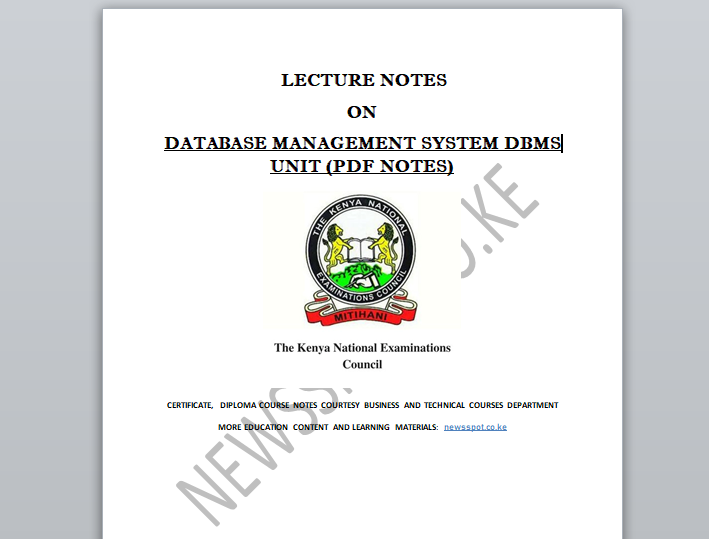Database management system DBMS outline and the notes in pdf highlighted here. Database management system DBMS unit is examinable by Kenya national examination council KNEC and is mainly taught in various courses highlighted below;
- Diploma in Information communication technology
- Diploma in ICT module 2
DATABASE MANAGEMENT SYSTEM DBMS UNIT: This unit trainees learn more about DBMS which is a system software for creating and managing databases. A DBMS makes it possible for end users to create, protect, read, update and delete data in a database.
DATABASE MANAGEMENT SYSTEM DBMS TOPICS COVERED
- DBMS introduction overview
- DBMS architecture
- DBMS data models
- DBMS data schemas
- DBMS data independence
- Entity relationship model
- Relational model
- Relational database design
- Storage and file structure
- Backup and recovery
DBMS introduction overview
This topic trainees will be able to learn; the basics of DBMS such as its architecture, data models, data schemas, data independence, E-R model, relation model, relational database design, and storage and file structure and much more.
DBMS architecture
This topic trainees will be able to learn; Database Architecture which is a representation of DBMS design. It helps to design, develop, implement, and maintain the database management system. A DBMS architecture allows dividing the database system into individual components that can be independently modified, changed, replaced, and altered
DBMS data models
This topic trainees will be able to learn; data models Some of the Data Models learned in this DBMS topic are:
- Hierarchical Model.
- Network Model.
- Entity-Relationship Model.
- Relational Model.
- Object-Oriented Data Model.
- Object-Relational Data Model.
- Flat Data Model.
- Semi-Structured Data Model.
DBMS data schemas
This topic trainees will be able to learn; DBMS Schemas which is of three types: Logical Schema, Physical Schema and view Schema. Logical Schema describes the database designed at logical level. Physical Schema describes the database designed at physical level.
DBMS data independence
This topic trainees will be able to learn; Data independence which is the type of data transparency that matters for a centralized DBMS. It refers to the immunity of user applications to changes made in the definition and organization of data
Entity relationship model
This topic trainees will be able to learn; Entity–relationship model ER model which describes the structure of a database with the help of a diagram, which is known as Entity Relationship Diagram (ER Diagram). An ER model is a design or blueprint of a database that can later be implemented as a database.
Relational model
This topic trainees will be able to learn; The relational model for database management which is an approach to managing data using a structure and language consistent with first-order predicate logic, first described in 1969 by English computer scientist Edgar F. Codd, where all data is represented in terms of tuples, grouped into relations
Relational database design
This topic trainees will be able to learn; Relational database design (RDD) which models information and data into a set of tables with rows and columns. Each row of a relation/table represents a record, and each column represents an attribute of data. The Structured Query Language (SQL) is used to manipulate relational databases.
Storage and file structure
This topic trainees will be able to learn; Storage and file, A file is a sequence of records stored in binary format. A disk drive is formatted into several blocks that can store records. File records are mapped onto those disk blocks.
Backup and recovery
This topic trainees will be able to learn; Backup and recovery which in general refers to the various strategies and operations involved in protecting your database against data loss and reconstructing the data should that loss occur.
- DATABASE MANAGEMENT SYSTEM DBMS NOTES (PDF)
- DATABASE BACKUP AND RECOVERY NOTES pdf
- GEOGRAPHICAL INFORMATION SYSTEM NOTES PDF
- NORMALIZATION NOTES PDF
- DBMS LIFECYCLE PDF
DBMS NOTES: Many students sitting for KNEC exams have found themselves on a difficult situation on How to pass DBMS unit and avoid fails and referred results. Its easy the simple steps to follow include;
- Reviewing previous KNEC past papers available for this unit
- Focus on your weak topics during revision
- Involve your Friends, Experts or tutors
- Good timely preparation
- Attempt all KNEC questions provided for this unit
Our comprehensive DBMS Notes in (PDF) format covers all the examinable topics with a definitive outline to enable easy understanding and guarantee flexibility in tackling the KNEC questions. You can access these and other notes from this PAGE
- DATABASE MANAGEMENT SYSTEM DBMS NOTES (PDF)
- DATABASE BACKUP AND RECOVERY NOTES pdf
- GEOGRAPHICAL INFORMATION SYSTEM NOTES PDF
- NORMALIZATION NOTES PDF
- DBMS LIFECYCLE PDF
KNEC grading system for colleges and TVETs exams
QUESTIONS AND ANSWERS TO STATISTICS, QUANTITATIVE TECHNIQUES, QUANTITATIVE METHODS E.T.C
- Frequency distribution table example with solution
- Examples & Formulas For Standard Deviation Variance Mean For Ungrouped Data
- Examples & formulas for standard deviation variance mean for grouped data
- Time series analysis least square method solved examples
- Price index Laspeyres Paasche’s and fisher’s ideal price index questions and answers
- Probability questions and answers statistics
- Pearson’s Coefficient of correlation formula example & solution
- PERT network diagram critical path example and solution project management
- Venn diagrams examples with solution 2 3 circles
- Regression equation formula how to calculate solved example
FREE KNEC PAST PAPERS PDF FORMAT:
- Diploma in ICT module 2 KNEC past papers Free download
- Diploma in ICT module 3 KNEC past papers Free download
- Certificate in ICT module 1 KNEC past papers Free download
- Certificate in ICT module 2 KNEC past papers Free download
- Diploma in Electrical and electronic engineering module 1 KNEC past papers Free download
- Diploma in electrical and electronic engineering module 2 KNEC past papers Free download
- Diploma in Human resource management module 1 KNEC past papers Free download
- Diploma in human resource management module 2 KNEC past papers Free download
- Craft in supply chain management module 1 KNEC past papers Free download
- Diploma in building technology module 1 KNEC PAST papers
- Diploma in building and technology module 2 KNEC past papers
- Diploma in building and technology module 3 KNEC past papers
- Diploma in civil engineering module 1 KNEC PAST PAPERS
- Diploma in civil engineering module 2 KNEC PAST PAPERS
- Diploma in civil engineering module 3 KNEC PAST PAPERS
- Certificate in electrical and electronic engineering module 1 KNEC PAST PAPERS
- Certificate in electrical and electronic engineering module 2 KNEC PAST PAPERS
- Craft in supply chain management module 2 KNEC PAST PAPERS
- Diploma in Quantity survey KNEC past papers
- Certificate in plumbing module 1 KNEC past papers
- Certificate in building and technology module 1 KNEC past papers
- Certificate in building and technology module 2 KNEC past papers
- Diploma in social work and community development module 1 KNEC past papers
- Diploma in social work and community development module 2 KNEC past papers
- Diploma in social work and community development module 3 KNEC past papers
- Diploma in electrical and electronic engineering module 3 KNEC past papers
- Diploma in Human resource management module 3 KNEC past papers
- Diploma in supply chain management module 3 KNEC past papers
- Diploma in supply chain management module 1 KNEC past papers
- Certificate in human resource management module 2 KNEC past papers
- Diploma in supply chain management module 2 KNEC past papers
- Certificate in human resource management module 1 KNEC past papers
- Certificate in food and beverage module 1 KNEC past papers
- Certificate in food and beverage module 2 KNEC past papers
- Diploma in catering and accommodation module 1 KNEC past papers
- Diploma in catering and accommodation module 2 KNEC past papers
- Diploma in catering and accommodation module 3 KNEC past papers
- Diploma in food and beverage module 1 KNEC past papers
- Diploma in food and beverage module 2 KNEC past papers
- Diploma in food and beverage module 3 KNEC past papers
- Diploma in tourism management module 1 KNEC past papers
- Diploma in tourism management module 2 KNEC past papers
- Diploma in tourism management module 3 KNEC past papers
- Certificate in tour guiding and travel operations module 1 KNEC past papers
- Certificate in tour guiding and travel operations module 2 KNEC past papers
- Diploma in business management module 1 KNEC past papers
- Diploma in business management module 2 KNEC past papers
- Diploma in business management module 3 KNEC past papers
- Diploma in sales and marketing module 1 KNEC past papers
- Diploma in sales and marketing module 2 KNEC past papers
- Certificate in business management module 1 KNEC past papers
- Certificate in business management module 2 KNEC past papers
- Certificate in project management module 1 KNEC past papers
- Certificate in project management module 2 KNEC past papers
- Certificate in sales and marketing module 1 KNEC past papers
- Diploma in agriculture module 1 KNEC past papers
- Diploma in agriculture module 2 KNEC past papers
- Diploma in agriculture module 3 KNEC past papers
- Diploma in early childhood development KNEC past papers
- Certificate in early childhood development and education KNEC past papers
COURSE NOTES
- Introduction to ICT and ethics notes PDF
- Communication skills notes PDF
- Entrepreneurship notes PDF
- Economics notes PDF
- Financial accounting notes PDF
- Business law notes PDF
- Research methodology notes PDF guide
- Trade project notes & PDF sample
- Principles and practice of marketing notes PDF
- Microprocessor systems notes PDF
- Management information system MIS notes PDF
- Data communication and networking notes PDF
- Internet based programming IBP notes PDF
- Quantitative methods notes PDF
- Visual basic notes PDF
- Object oriented programming notes PDF
- System analysis and design notes PDF
- Quantitative techniques notes PDF
- Principles and practice of management PPM notes PDF

